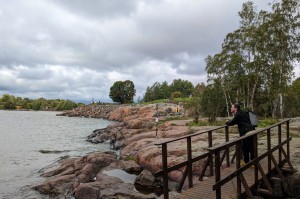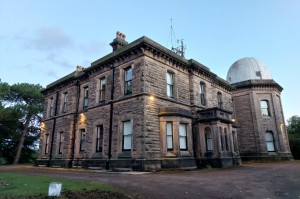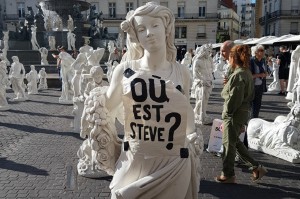Field Trip: Sketches From Venice, Chapter Two
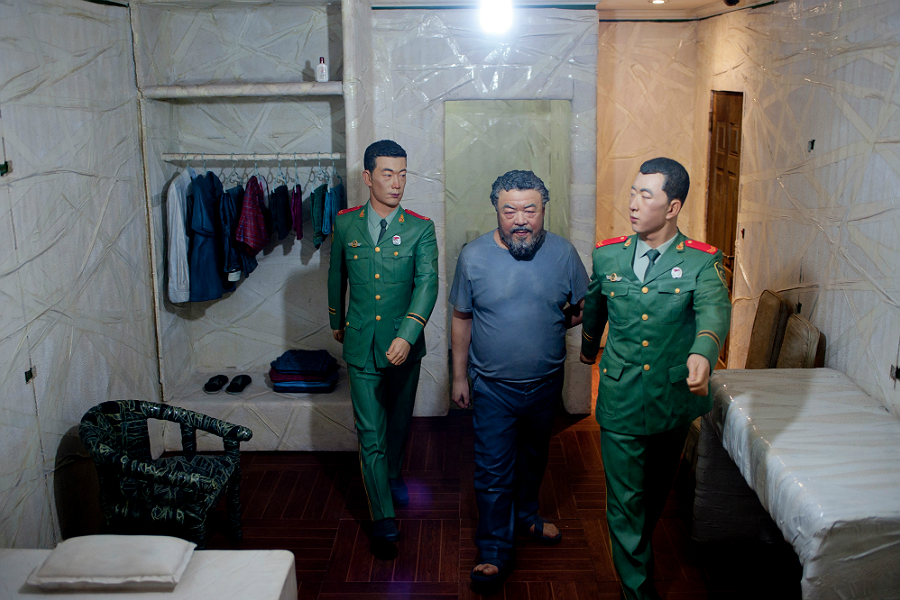
In chapter two of her Venice odyssey, Ruth Dillon has no option but to giver herself over to a full art overdose…
The 55th Venice Biennale is immense. Venice is a city consumed by, built upon and source of art; from Tintoretto to Marino Auriti, the man who was the inspiration behind the 55th Venice Biennale.
Marino Auriti had a dream; his vision, to create Il Palazzo Enciclopedico, a space to hold knowledge of all types, with no hierarchy or division. The Biennale holds fast to the idea of an Encyclopedic Palace; artefacts sit alongside artworks, creating a unique dynamism in the city.
The Giardini hosts the central pavilion, and the artiglierie. Artworks from Richard Serra, Shinro Ohtake, Steve McQueen, Mark Manders, Tacita Dean, Imran Qureshi, Aleister Crowley, Gianfranco Baruchello, Xul Solar, Sarah Lucas and Eva Kotatkova sit amidst resplendent architecture.
It is easy to O.D. on art here: the work, and in particular the artists, hold me suspended, in time and place, make me question, think, stop and breathe…
Ai Wei Wei is an artist of monumental ambition and achievements. His socially engaged practice is to be respected, digested, and acts as a remedy to more non-descript practitioners who shy away from the real; great art should always have the capacity to create a dissenting perspective.
Housed in Sant’Antonin, Castello, and Guidecca Island, are Straight and Sacred. Sacred is a sculptural installation in direct response to his experience of incarceration for alleged tax evasion.
Straight references an earthquake in 2008, a natural catastrophe that due to faulty government buildings saw the death of 5000 schoolchildren. For this work Wei Wei sourced more than 100 tonnes of rebar (twisted metal structures) from the rubble and spent three years restoring them to their original forms.
The work is calming and allows for a kind of reflective reverence. The floor installation is simple, strong and creates perspectives reminiscent of those found in nature: undulating lines roll like hills in a landscape. The rusted twisted metal compels one to adjust one’s position, allowing for line, shape and shadow to reveal itself in space.
So to Dutchman Mark Manders. For me, Manders’ work, Room with Broken Sentence, is a Biennale highlight. An installation of consummate skill and epic proportions, the work spans 23 years, combining older works with the new four metre high Working Table.
A traditional bust, spliced and supported by wood, the visual impact is direct, and impressive, the languages of the materials subverted, creating a new discourse, whilst also bringing an element of the formal and conceptual vocabulary of the artist.
A window installation of newspapers cleverly uses every word in the English language, the handcrafted pieces are harmonious and insightful, presented (and received) as a coherent whole; mysterious, tender, strong and inspired.
At the Istituo Santa Maria Della Pieta was the New Zealand pavilion and Bill Culbert’s Front Door Out Back, an eight-part installation, which relates primarily to the domestic world, normal pieces of furniture are appropriated and arranged as objects d’art.
Light is a key aspect; the entrance is long and a single sheet of glass sits at the end of the hallway, reflecting the light from the Riva Degli Schiavoni. As you stand at the entrance your own form becomes shadow, in turn becoming part of the installation.
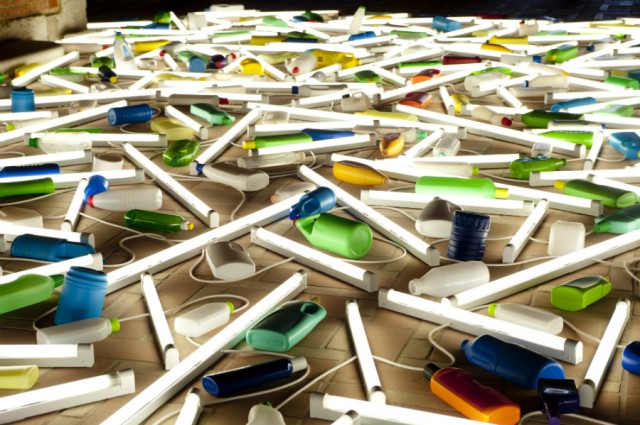
Daylight Flotsam Venice – plastic vessels which would ordinarily house cleaning materials – is placed in the grand hall, arranged and linked by fluorescent lights. The carpet of light and shape renders the bottles into a morphing swamp of lines. Low light levels create a kind of broken geometry; no shadow or reflection is cast; a reference to (or subversion of) the Venice glass blowing trade perhaps?
In a smaller room off the main garden, is Where are The Other Two? where various types of chairs and tables house fluorescent light, the lights placed vertically through the centre of each table. Sculpturally strong, these works have an integrity that creates energy.
Culbert has said he hoped that the spaces could bring one on a journey, a journey much like the continuous flow of water on the canals of Venice. He noted that the entire space is at land level and water level, referencing the importance of line in this year’s Biennale work.
Parallel Convergences at Casa Dei Trei Oci, saw the works of Anatoly Osmolosvky and Pawel Althamer juxtaposed, by curator Thomas Cullinan. A collateral project for Moscow based V-A-C foundation, the artists – one Russian one Polish – share the generational connection of living through communism to post communism.
Political and subversive, the focus for Althamer is inner exploration, the human, and in an eight piece film installation, we see him (and a series of collaborators) experiencing altered states of consciousness – from LSD to peyote induced states to hypnosis a la rural.
Osmolovsky can be considered the more direct of the two. His film installation Seven Deaths in Moscow was arresting, disturbing, and truly unnerving: I felt in the presence of true suffering.
Past works include actions and provocations, intended as acts of creative and political expression, which could be termed as punk performative interventions. A sculptural piece on exhibition here is a floor; normal save for three upturned pieces, sharp, graceful and cutting.
On the second floor I notice a broom. The broom held a flag; it had been carefully placed in such a way as to easily miss the work. This subtlety subverts the normal perimeters of the gallery, creating sculpture in spaces where audiences aren’t expected to experience art.
Osmolovsky’s art was a tonic to the mundane beige of the current social climate, where so many people digest endless amounts of reality TV fodder, and chat happily about the new constructed TV pop star, but balk at discussing much of import.
More upbeat was Tacita Dean’s work; as ever, simply ephemeral. Her slow moving film hovered and swayed over a simple drawing; a backlit projection hung in the air, ensconced in a darkened space with room for only one chair, making viewing personal yet expansive.
Working within a solid framework of cinema, cinematic history is unified with an artistic sensibility. Dean manages to at once transport and place the viewer in a landscape of history, context and beauty; an illusory experience.
Dealing with the fears, anxieties, phantasms and phobias taken from accounts of psychiatric patients, and children who have difficulty communicating with the external world, Eva Kotatkova presented Asylum, “A fragmented model, which is composed from several small segments, either of metal structures, paper cut outs, texts and many images.”
The work acts as a visual archive or catalogue. The presence of a grid/cage (which has featured in Kotatkova’s earlier works), acts as a visual statement: the observer is externalised, creating a safe distance, thus divorcing us from the disturbing elements of the human psyche.
The mixed media installation also examines the psychological effects of institutions and disciplinary structures, which further act as barriers to individuals who are already at odds with the world.
I want to close with Carl Jung’s Red Book (or Liber Novus). The collected drawings and musings of the great Swiss psychotherapist, exhibited for the first time as art works in and of themselves.
Termed as record visions through a process he called active imagination, these works (created 1914-1930) are known to have inspired and assisted him in the development of his theories and one such concept known today as the collective unconscious.
Fascinated by Tibetan Buddhism, and in particular the Tibetan mandala, the mythic imagery held within the Red Book, was a direct result of a difficult period in Jung’s own life, a period he classed as a creative illness.
During this time he confronted his own mind and explored notions of archetypes, individuation and collective unconscious. This period saw Jung identify and confront the anima and animus of his own psyche.
It has been suggested that for creative illness we could also read extended episode of psychosis. Whatever Jung experienced I think a touch of madness often borders on genius and is more normal, for want of a better word, than we care to admit.
Where would we be today if creative illness (or whatever term you choose to use) ceased to exist? What a sanitary, clinical and less interesting place the world would be.
Words: Ruth Dillon, Pictures: Mina Bihi
Venice Biennale continues until 24th November



